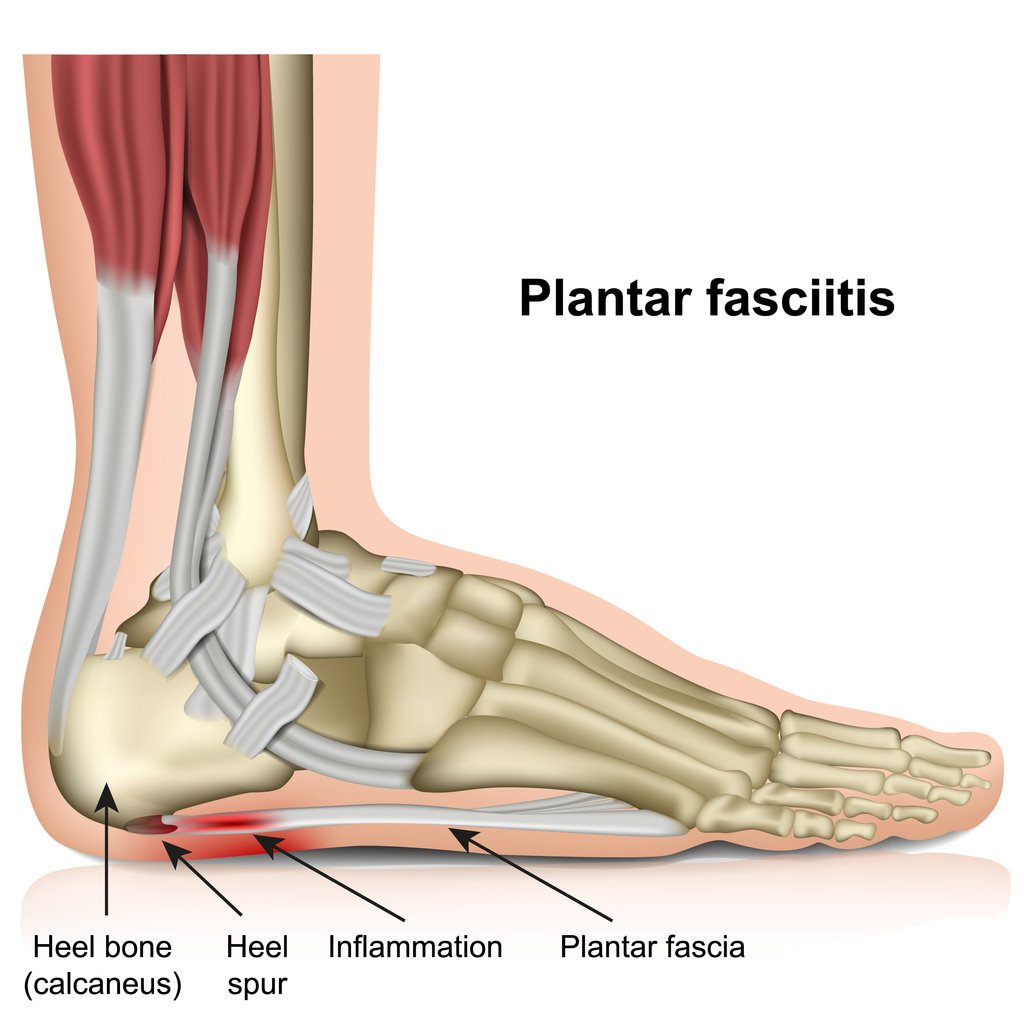Imagine waking up to the first rays of sunlight gently caressing your face, the promise of a new day beckoning you to step out of bed. But as your feet hit the floor, a sharp, searing pain shoots from your heel through your foot, turning that first step into a grimace of pain rather than a stride of optimism. This is the daily reality for the millions of people suffering from plantar fasciitis, a condition characterized by the inflammation of the plantar fascia, the thick band of tissue that runs across the bottom of your foot and connects your heel bone to your toes. The journey with plantar fasciitis is often long and fraught with trial and error in finding relief, making it not just a physical challenge, but a mental one as well. So, lets explore plantar fasciitis and mindfulness!
Understanding Plantar Fasciitis
The prevalence of plantar fasciitis is significant, affecting approximately 1 in 10 people at some point in their lives, according to a study published in the “Journal of Research in Medical Sciences.” The condition is most common in people aged 40 to 60 years old. Yet, the physical discomfort is just one aspect of the condition; the psychological toll it takes can be equally debilitating. As each step becomes a reminder of the persistent pain, sufferers often find themselves in a constant state of stress and frustration, exacerbating the condition further.

The Nature of Plantar Fasciitis
The plantar fascia is a thick band of tissue that acts as a shock absorber, supporting the arch of the foot. When the plantar fascia becomes inflamed, it can result in stabbing pain at the bottom of the foot, particularly in the heel area. This pain often worsens with prolonged standing or walking.
The condition can make it challenging to engage in physical activities, affecting the overall quality of life. Mindful movement practices, such as yoga, can help stretch and strengthen the plantar fascia, complementing traditional treatment methods.
- Plantar fasciitis affects the thick band of tissue along the bottom of the foot.
- Common symptoms include stabbing pain in the heel and arch of the foot.
- Inflammation of the plantar fascia can lead to heel spurs if left untreated.
- Mindful movement practices like yoga can complement traditional treatments.
- Foot care, including proper footwear, is essential in managing plantar fasciitis.
How can Mindfulness Help?
Enter mindfulness, a beacon of hope on this challenging journey. Mindfulness is the practice of bringing one’s attention to the present moment without judgment, a technique that has been shown to reduce stress and improve mental well-being. For those grappling with plantar fasciitis, mindfulness offers a dual approach to managing their condition: reducing the psychological distress associated with chronic pain and potentially alleviating the physical symptoms themselves.
There are several techniques of mindfulness that can be particularly beneficial for those suffering from plantar fasciitis:
- Mindful Breathing: This involves focusing on your breath, noticing each inhalation and exhalation, and the sensations they bring. Mindful breathing can help center your thoughts and reduce the intensity of pain perception.
- Body Scan Meditation: This technique involves mentally scanning your body for areas of tension and consciously releasing that tension. It can be especially helpful in identifying and relaxing the muscles around the plantar fascia.
- Mindful Walking: Although it may seem counterintuitive for those with foot pain, mindful walking can be adapted to be very gentle and can help sufferers reconnect with their bodies in a positive way, focusing on the sensation of movement rather than the pain.
- Loving-kindness Meditation: This practice involves directing positive thoughts and wishes of well-being towards oneself and others. It can be particularly helpful in managing the frustration and negative emotions that often accompany chronic pain conditions like plantar fasciitis.
Integrating mindfulness into the daily routine can offer a sense of control over the condition, providing a tool that can be used anytime to manage stress and pain. Moreover, mindfulness can enhance the effectiveness of other treatments by improving one’s mental state and reducing stress-related inflammation.

Practical Ways to Integrate Mindfulness into Daily Life
Incorporating mindfulness techniques into daily routines can enhance well-being. One practical way is to start the day with a moment of mindfulness before getting out of bed. Setting aside time for mindful activities like meditation or deep breathing exercises during breaks can promote relaxation and focus.
Another approach is to integrate mindfulness into tasks like washing dishes or walking by paying attention to sensations. These small practices can gradually cultivate a more mindful lifestyle, leading to improved overall health and stress management.
Mindfulness Techniques for Pain Management
Mindful breathing techniques aid in easing discomfort related to foot issues, focusing on the breath for relief. Body scan meditations heighten awareness of pain locations, aiding in targeted therapy.
Progressive relaxation, through muscle tensing and release, reduces tension, enhancing healing. Incorporating gentle yoga poses promotes pain reduction by increasing mindfulness in movement. Shifting attention from pain to the present moment using mindfulness practices shows promise in pain management strategies.
Establishing a Regular Mindfulness Practice
To establish a regular mindfulness practice, designate a daily time slot for consistency. Craft a serene space for sessions and utilize cues for awareness prompts. Engage in mindfulness classes or groups for motivation and connection. Reflect on mindfulness benefits to strengthen commitment. Remember, consistency is key in fostering a meaningful mindfulness routine.

Creating a Holistic Healing Environment
Combining physical therapy with mindfulness can be a valuable addition to your treatment plan. Integrating strategies for long-term pain management, such as establishing a regular mindfulness practice, could provide health benefits. By fusing together these elements in a holistic approach, like using a chair for specific exercises targeting the heel bone and Achilles tendon, you can create a well-rounded healing environment.
The Cleveland Clinic suggests that incorporating ligament-strengthening routines, guided by experts like Maddie, alongside mindfulness techniques, can be a game-changer for your healing journey.
Combining Physical Therapy and Mindfulness
By integrating mindfulness practices with physical therapy, a holistic approach to recovery can be achieved. Mindfulness not only supports rehabilitation progress but also enhances patient compliance and engagement with the treatment plan.
This combination of approaches can lead to improved outcomes, promoting overall well-being and encouraging a valuable addition to the healing process. The integration of mindfulness and physical therapy can play a crucial role in optimizing health benefits and aiding in long-term pain management.
Strategies for Long-term Pain Management
Strategies for long-term pain management involve incorporating mindfulness practices like meditation to reduce stress. Utilize mindful movements such as yoga to enhance flexibility and relieve foot tension. Embrace a holistic healing approach by integrating mindfulness into your daily wellness routine.
Seek expert advice from healthcare providers specializing in mindfulness-based pain management for effective guidance. Cultivate patience and self-compassion throughout your healing journey from plantar fasciitis.
Could Mindfulness Be the Missing Piece in Your Healing Journey?
Mindfulness might be the key to easing plantar fasciitis pain and emotional strain. Engage in practices like meditation and deep breathing for potential inflammation reduction and healing enhancement. Enhance resilience, cope with chronic pain, and boost overall well-being by integrating mindfulness into your healing path.

Conclusion – Plantar Fasciitis and Mindfulness
In conclusion, while plantar fasciitis presents a challenging road for many, the integration of mindfulness techniques offers a holistic path towards managing the condition. By embracing the present moment with kindness and without judgment, sufferers can find a sense of peace amidst the pain, potentially easing their symptoms and improving their quality of life. As we reflect on the journey of healing, one question remains: What step will you take today towards your path of recovery?
I hope you have found this blog helpful and please feel free to comment and share.
Thanks for reading!
 | Tracy J. Founder, The heel GP |
